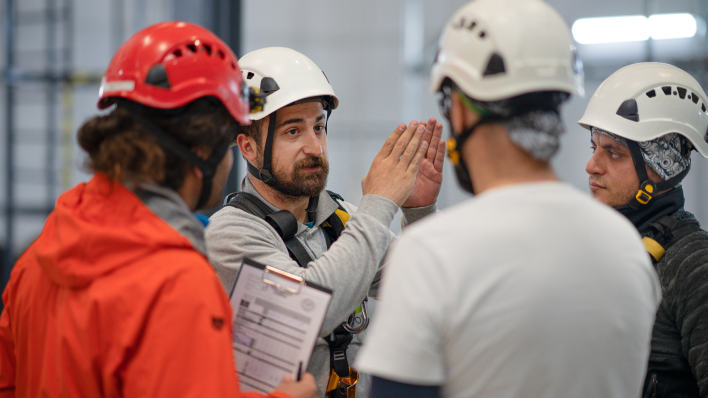In the ever-evolving landscapes of manufacturing and construction, safety compliance remains an unwavering pillar that ensures not only the protection of workers but also the operational efficiency of businesses. Losing a worker for days, weeks, or even months is not only seen as a failure on the part of the company, but it can also put a serious strain on finances. Strict compliance with the safety standards set forth by the Occupational Safety and Health Administration (OSHA) should be the goal of all health and safety managers.
Understanding OSHA's Role
OSHA's primary objective is to ensure safe and healthy working conditions by setting and enforcing standards. Through regular inspections and guidance, OSHA aids businesses in identifying potential hazards, thereby preventing workplace injuries and fatalities. For manufacturers, aligning with OSHA standards is not just about safety compliance; it is an investment in workforce safety and productivity.
OSHA annually highlights the top 10 safety violations to guide enterprises in fortifying their safety practices. Understanding these violations is imperative for manufacturing business owners, workforce development professionals, and technology consultants dedicated to fostering a safe and progressive working environment.
Top 10 OSHA Safety Violations
Here are the most-cited OSHA violations for 2023. (Note, the order may change year-to-year but there is not much variation in which violations make the list).
- Fall Protection (7,271 violations)
Consistently topping the list, fall protection violations predominantly occur in construction but are equally pertinent to manufacturing sectors with elevated work areas. Falls are the leading cause of death in the construction industry, making fall protection a crucial element of any safety program. - Hazard Communication (3,213 violations)
Manufacturers must ensure that all hazardous chemicals are properly labeled and that safety data sheets are accessible, facilitating informed handling by employees. - Ladders (2,978 violations)
Improper use of ladders can lead to serious accidents. Regular training on proper ladder safety and maintenance is vital. Guidelines regarding ladder size, setup and usage are spelled out in this standard. - Scaffolding (2,859 violations)
Scaffold-related incidents often result from inadequate assembly and training. Regular inspections and adherence to safety protocols are essential. - Lockout/Tagout (2,554 violations)
Lockout/tagout (LOTO) violations highlight the critical need for procedures that ensure machinery is properly shut off during maintenance. This prevents accidental startups that could lead to severe injuries. - Powered Industrial Trucks (2,561 violations)
Forklifts and similar equipment require thorough operator training and regular maintenance checks to prevent accidents. - Respiratory Protection (2,481 violations)
In environments where air quality is compromised, appropriate respiratory protection must be available and fit-tested to safeguard workers' health. - Fall Protection Training (2,112 violations)
In addition to ensuring that equipment and procedures are in place to help prevent falls, educating employees on how to prevent falls is a distinct requirement. - Eye and Face Protection (2,074 violations)
Wherever there is a risk of flying particles or harmful chemicals, appropriate eye and face protection should be enforced. - Machine Guarding (1,644 violations)
Unprotected machinery poses significant risk. Installing proper guards and regularly training employees on their operation can mitigate these dangers.
OSHA inspections have been increasing year-to-year, as have fines. But fines are merely a warning sign that your company is at increased risk for accidents and injuries. And this is where the real costs lie. When a worker is sidelined, the company is responsible for workers’ compensation, health insurance and even possible legal action. Indirect costs can be just as damaging: morale could plummet due to workers fearing for their own safety, especially if they’re asked to put in extra hours; turnover could rise and production may suffer.
Top 10 Workplace Injuries
Here is Liberty Mutual Insurance’s 2024 Workforce Safety Index listing the top 10 workplace injuries across all industries.
- Overexertion involving outside sources (lifting, pushing or pulling an object)
- Falls on same level (think slippery floors)
- Falls to lower level (as from a ladder)
- Struck by object or equipment (unsecured tools, racks or product)
- Other exertions or bodily reactions (awkward poses or climbing out of a vehicle)
- Roadway incidents involving motorized land vehicles
- Slip or trip without fall
- Caught in or compressed by equipment or objects
- Struck against object or equipment
- Repetitive motions involving microtasks
The number one injury, both in terms of frequency and cost is injury to the back. This is one of the reasons that overexertion occupies the top spot on the list, accounting for $12.49 billion in costs each year.
Back injuries are also one of the results of “falls on same level.” These incidents cost American industries $9.9 billion per year.
Strategies for Compliance and Prevention
Employers must prioritize safety training and continuous learning to adapt to technological advancements in manufacturing. By integrating technology such as safety management software, businesses can streamline safety compliance processes and ensure real-time monitoring of workplace safety.
Workforce development professionals should focus on crafting training programs that encompass these safety requirements, preparing the workforce to meet the industry's dynamic demands. A good place to start is with the OSHA Education Center, which offers a wide array of online courses.
Manpower’s safety program
Manpower has a safety training program for our associates that’s tailored specifically to the client’s worksite. Our 7-point safety review process starts with a site visit and a work environment survey, and proceeds with training in proper lifting, PPE, HAZMAT handling, etc. as needed. We also have detailed incident and claims reporting procedures, 24/7 access to a nurse, and timely and accurate reminders to the client regarding OSHA log documentation. This program is designed to protect our workers and reduce associate claims for our clients.
Worth the investment
Investing in workplace safety and health training may involve some initial expenses, but these are minimal compared to the potential costs of a serious accident or injury. According to a study by Liberty Mutual Insurance Company, over 60% of CFOs reported that every $1 spent on injury prevention yielded a return of $2 or more. These essential programs not only provide a significant return on investment but also save your business thousands of dollars in indirect costs associated with accidents.
By preparing and preventing injury, businesses can not only comply with safety standards but also cultivate a culture of safety that underscores their long-term success.
Need qualified workers trained in your safety requirements? Contact us






